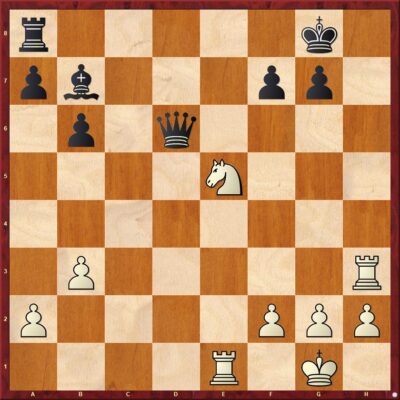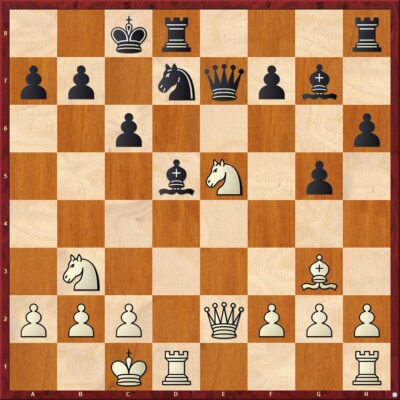In chess, a tactic refers to a sequence of moves that limits the opponent’s options and may result in gain of material or checkmate.
“Chess is 99% Tactics”
Famous Chess quote from Savielly Tartakower.
A lot of games in chess are decided by tactical means and one should be really alert during the games to spot them. There are recurring tactical patterns which occur frequently.
Let us look at 7 of the important ones here. Some occur frequently, while some are rare, but extremely dangerous.
1) Fork
It’s a tactical motif that allows a piece to attack two different pieces simultaneously. Unable to defend both the pieces, our opponent must give up a piece.

1.Rh8+!
White sacrifices his rook to be able to create the fork] 1…Kxh8 2.Nxf7+
This is a typical fork. The knight is giving a check to Black’s as well as attacks the black Queen.

2…Kg8 3.Nxd6
Because of the tactical motif of the fork White was able to win the Black Queen in the above position.
Moving on to the next tactic…
2) Pin
When a piece can’t move because it guards a more valuable piece behind it from being captured, that piece is said to be pinned. This is a very common tactic, one that you’ll find in almost every other game.

It’s White to play. Try to solve it on your own, before looking at the solution.
1.Rxd6 Rxd6 2.e5!

The key idea of this tactical motif: White pins the rook to the Black king and increases the number of attackers.
Or as they say – “Pin them to win them!”
2…Ke6 3.exd6!
3.Bxd6?? f6 draws as Black is able to trade off the last pawns on the board. Tricked you there!
3…Kd7 4.Ke3 Ke6 5.Ke4 and White wins.
3) Skewer
Skewer is a tactical motif that threatens a valuable piece directly (such as the king or queen), and forces that piece to move away, as a result of which the less valuable piece behind is captured.
Basically, a skewer is a pin in the opposite order.

This position provides multiple skewer examples, eventually climaxing and a White victory.
1.Ra8!
The key idea of this tactical motif: The rook is untouchable due to a skewer of the king and queen after 1…Qxa8 2.Bf3+ Kb6 3.Bxa8 and White wins.
1…Qa2
The only safe square for the queen. 1…Qe6 is met with 2.Ra6+.
1…Qc4 is met with 2.Rc8+.
1…Qd5 is met with 2.Bf3 and the Queen is pinned!
2.Rxa4 Qg8
Once again 2…Qxa4 3.Be8+ wins.
3.Ra8 Qh7 4.Bg6!
4…Qxg6 5.Ra6+

Notice that in all the variations, the most valuable piece (the king) was in front of the relatively less valuable piece(the queen). That’s why this tactic is a skewer, not a pin!
4) Double Attack
As the name suggests, double attack happens when you issue two different threats in one move. Sometimes, the two threats can be so powerful that they force the opponent to resign on the spot itself!

It is White to play. This is the simplest exercise of all!
1.Bxg7!

And White has two threats. One is to capture on h8 and the other is to give a mate on d8. Black can’t defend both and it’s game over.
5) Windmill
It’s a rare tactic in which one piece goes on a rampage giving many discovered checks without giving the opponent king a chance to breathe air. It’s rare, but when it occurs, it’s deadly!

This game between Carlos Torre vs Emanuel Lasker is perhaps the most famous windmill tactic in the history of chess.
1.Bf6!! Qxh5 2.Rxg7+
The key idea of this tactical motif: White captures on g7, and begins a series of checks – all forced and inescapable by black – that inevitably lead to a huge loss in material.
2…Kh8 3.Rxf7+ Kg8 4.Rg7+

The White rook is gonna capture everything standing in its way!
4…Kh8 5.Rxb7+ Kg8 6.Rg7+ Kh8 7.Rg5+!
This is better than capturing the a-pawn as it opens the a-file for the Black rook.

7…Kh7 8.Rxh5 Kg6 9.Rh3 Kxf6 10.Rxh6+ and White went on to win.
6) Double Check
Checking the enemy king with two different pieces from two different directions on the same move is very powerful. Sometimes it can be a checkmate too!
That’s why it’s one of the best tactics out there!

In the above position White’s about to lose the exchange because his Rook is pinned. What can they do?
1.Bd6+!

This check creates a deadly double-check on the Black king. Black would love to take either the rook or the bishop here, but can’t take both. After the king moves, White will take the bishop, to which the Rf2 will say – “Thank God!”
Also 1.Be3+ was working perfectly well. That would be termed as a discovered check, which brings us to the last tactic on the list…
7) Discovered Attack
Discovered Attack occurs when a piece moves out of the way opening a file to attack on another piece in the opponent camp.

White has a shocker here.
1.Nxc6!

The key idea of this tactical motif is that White captures the c6 pawn, placing a discovered attack on the Black queen by their own queen on e2.
1…Bxc6
If 1…Qxe2 2.Nxa7#.
And if 1…bxc6 2.Qa6#
2.Qxe7 wins a queen.
1–0
I hope you found the examples fun and instructive.
Conclusion
We have looked at 7 types of chess tactics. These occur more often than not and every chess player should have them in their arsenal!
Learning to identify tactics is a crucial skill for every chess player. Great tacticians like GM Mikhail Tal, GM Judit Polgar, and GM Garry Kasparov have made history because of their amazing tactical abilities.
Before concluding, here’s are my 3 cents on improving your tactical abilities –
- Study Tactical Patterns (Motifs)
The tactical combinations that appear in chess puzzles often share recognizable patterns and ideas. Such typical patterns and ideas are referred to as “themes” or “motifs.” Study such motifs as we looked above in the article.
- Develop Your Tactical Awareness
Knowing when to look for tactical combinations is a skill which is just as important as the skill of finding tactical combinations. The key to know when to look for tactical combinations is to develop a tactical awareness. Once again, solving puzzles and themes will help you in this.
- Improve Your Visualization
Visualization refers to your ability to see in your mind the positions you will reach if certain moves were to be made. The skill to visualize possible tactics in your mind long before they actually appear on the board, gives you a serious advantage over any opponent who can’t do it. I hope this guide on the best Chess tactics for beginners and intermediates helped you.
Good luck solving tactics!
This article has been written by Ojas Kulkarni who’s a 2200+ elo-rated player.

